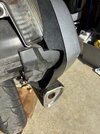basketcase
Site Supporter
So yesterday I'm working the back fender out of the recesses getting ready for a tire change and I noticed a crack in the pvc. It was already there but invisible when not under pressure.
About the time I said to myself "I better be careful with that" the crack advanced in a loop so a piece of pvc popped out and landed on the deck.
The pieces fit back perfectly, but refastening it for a seamless appearance and not to forget, a durable and permanent fix, will be another story.
The type of adhesive I want is one of the plastic-glues that allow a bit of time for "working" the pieces into a snug fit, and then spraying with an activator to accelerate curing.
Can any of you offer a suggestion of something you have used that fits the above criteria?
Thanks in advance,
Rick
About the time I said to myself "I better be careful with that" the crack advanced in a loop so a piece of pvc popped out and landed on the deck.
The pieces fit back perfectly, but refastening it for a seamless appearance and not to forget, a durable and permanent fix, will be another story.
The type of adhesive I want is one of the plastic-glues that allow a bit of time for "working" the pieces into a snug fit, and then spraying with an activator to accelerate curing.
Can any of you offer a suggestion of something you have used that fits the above criteria?
Thanks in advance,
Rick


 ).
).

